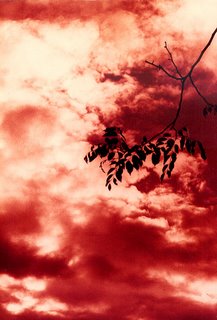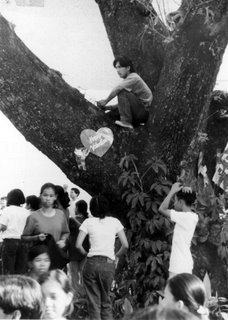A lot of you have probably seen the movie “Dead Poets Society” starring Robin Williams and directed by Peter Weir. Remember what the character played by Robin Williams said to his students as they faced a wall filled with pictures of previous generations of students now dead and gone? “Carpe diem.” Or in the English language, seize the day; seize the moment. This day, once the sun has set, will be over forever. This moment, once it has occurred, will be gone forever. As Chairman Mao Zedong also said, “Seize the day! Seize the hour!” But he probably wasn’t talking about photography ...
Greatest appeal of photography: capturing the decisive moment
The greatest appeal of photography to a lot of people is its ability to record an image, an action, a gesture, or an expression at a precise and unique, oftentimes never to be repeated moment in time and space. (As Sophia Coppola, daughter of world-renowned “Godfather” film series director Francis Ford Coppola once said in a magazine interview, “Painting takes too long. Photography is instant.”) For an example of an aesthetically-pleasing image taken at the decisive moment, look at the picture below of high school folk dancers practicing.
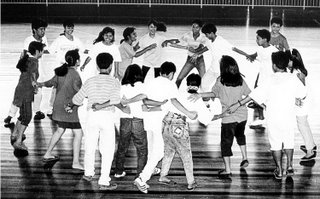 The world-renowned French photographer Henri Cartiér Brésson described this moment as the “decisive moment.” When you shoot an image at the decisive moment, you create a visually, emotionally, and intellectually satisfying photograph. Photography more than any other creative art, can seize this decisive moment, this “one moment in time” as singer Whitney Houston describes it, when everything just falls neatly into place.
The world-renowned French photographer Henri Cartiér Brésson described this moment as the “decisive moment.” When you shoot an image at the decisive moment, you create a visually, emotionally, and intellectually satisfying photograph. Photography more than any other creative art, can seize this decisive moment, this “one moment in time” as singer Whitney Houston describes it, when everything just falls neatly into place.
How do you capture this decisive moment, this one moment in time?
(1) Pay attention to what’s happening around you; don’t be like the photographer in the famous Kitkat chocolate commercial.
(2) Anticipate the moment.
(3) Watch the practices or rehearsals in your school’s activities, so you won’t be caught unprepared.
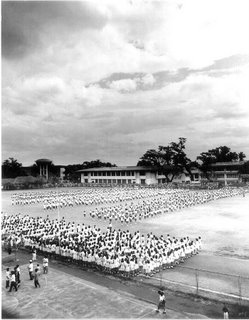 What’s the decisive moment in the picture above?
What’s the decisive moment in the picture above? Well, it’s Field Demonstration time, and with an activity like this, the students acting as a group are always emphasized. They form various patterns and perform intricate movements with props such as hats, ribbons and fans.
I wanted a picture that would express a person’s uniqueness or individuality rising above, as it were, the group’s collective identity.
I had already used up two rolls of Tri-X film (my favorite Kodak black and white film), shooting all the participants from various angles. I was down to the last four frames of my third and last roll. I chose a high viewpoint and pre-focused, using the small flagpole at the lower left side of the picture as my focusing guide. I had averaged my exposure; I metered the foreground at f/8, the middle ground at f/5.6, the sky at f/22. I set my lens to f/11. I had to do some “burning-in” later on in the darkroom to get the clouds.
Hey, don’t let all these numbers (f/5.6, f/22, etc) and terms like pre-focusing and averaging the exposure intimidate you, okay? We will discuss these topics later on, I promise.
Notice the girl at the lower right hand corner of the picture. She was tracing with her steps the boundary lines of the basketball court.
When I saw this girl, I took the shot! Notice that her left foot is at the apex of a small triangle, with the edge of the picture forming the base of that triangle. I had the picture I wanted — the seniors making their entrance into the field, the juniors waiting for their turn to perform, and this girl! Notice also that lines are the most prominent element in this picture.
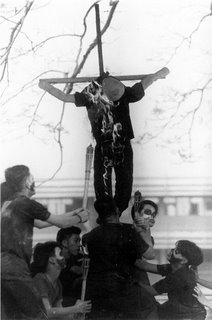 I really don’t want to admit it, but I nearly missed taking the picture above.
I really don’t want to admit it, but I nearly missed taking the picture above. These students were burning on a cross their classmate who attended math class despite their agreement that everyone would do cross-stitching that day. Just kidding, okay? Actually, the students were doing a choral recitation of “Ang Gabi ni Armando Castro.” I didn’t follow the advice I gave you several paragraphs ago. I didn’t watch the practices, and I wasn’t paying attention to what was happening. Sorry!
When the students raised this cross, the flames started eating up the kerosene-soaked effigy in a matter of seconds. I just had enough time to raise my camera and shoot two frames. I had my Vivitar 70-210 mm Series I zoom lens set at 150 mm, and I opened up the lens to f/5.6 because I was shooting against the light. So remember, watch the practices and pay attention to what’s happening around you!
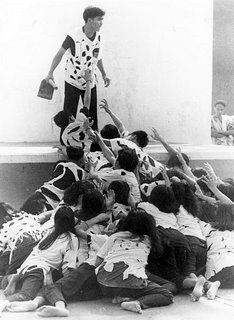 Picture above, again, I didn’t watch the practices, and I wasn’t paying attention to what was happening. Sorry!
Picture above, again, I didn’t watch the practices, and I wasn’t paying attention to what was happening. Sorry! As Alanis Morissette sang in “Ironic,” this was good advice I just couldn’t take! It was nearly lunch time, I was so hungry (pizza!), and I was busy talking to some pretty girls. The students were performing “A Man with a Toe,” I mean, “A Man with a Hoe.” I told you I was hungry! When I saw this great formation, I took two steps forward, raised my camera, and focused. I was able to take only one shot.
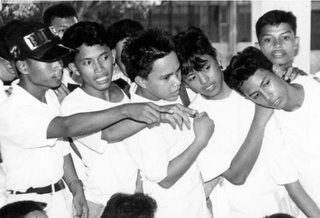

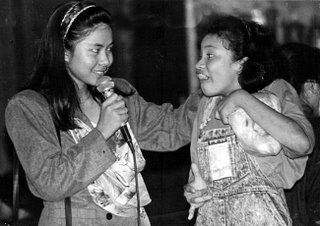 The term “decisive moment” doesn’t only mean blockbuster actions or earth-shaking events.
The term “decisive moment” doesn’t only mean blockbuster actions or earth-shaking events. It may also refer to something so ordinary as a group of boys studying for the NSAT (first picture immediately above) and the fine singing form of the choir members in the second picture. It also refers to capturing great expressions (notice the eyes of the best actress in the third picture).
Luck sometimes plays an important role in taking a good photograph, but remember, the harder you work, the luckier you get! Or as a philosopher has put it, “Chance favors the prepared mind.” Of course, capturing the decisive moment presupposes that you have already mastered the basic skills. You can’t be fiddling around with your shutter speed dial or aperture setting ring, or trying to focus on your subject while the decisive moment is taking place! (More on these topics later on, I promise.)
Be a better writer or editor through StyleWriter 4: this software checks 10,000 words in 12 seconds for hundreds of style and English usage issues like wordy and complex sentences, passive voice, nominalization, jargon, clichés, readability, spelling, etc.
StyleWriter 4 graphs your style and sentence variety, and identifies your writing habits to give an instant view of your writing. You can learn to adjust your writing style to suit your audience and task. You can learn, for example, the writing style of Newsweek, Time, The Economist, and Scientific American.
StyleWriter 4 is widely used in the US federal government (for example, the Environmental Protection Agency). It can be used by educators, students, and professionals in various fields - business, law, social or physical science, medicine, nursing, engineering, public relations, human resources, journalism, accounting, etc. Download your free 14-day trial copy now. |
Decisive moment vs. random moment
While Cartiér Brésson has exerted perhaps the strongest influence on photojournalism, his influence is counterbalanced by another photographer, Robert Frank, who has been called the “master of randomness.”
Frank believes that it is the “random moment” rather than the “decisive moment” that best defines and portrays what life is all about. It’s difficult trying to explain in words the difference between a photograph shot at the decisive moment, and a photograph of the same subject shot at a random moment. It would be much better for you to look at Frank’s photographs to really understand what he’s trying to say.
In the late 1950’s, Frank went on a 14 month trip throughout the American continent. All in all, he shot 600 rolls of black and white film using a Leica camera. He later used just 83 images for his 1959 book “The Americans” which has been hailed by many people as the most influential book ever in the field of photography.
At 36 frames per roll, Frank must have shot a total of nearly 22,000 pictures, and out of these, he used only 83 pictures in his book. That means he used less than one half of one percent of all the pictures he shot! Boy, my calculator’s good! In the immortal words of Nancy, Sluggo’s partner in the cartoon strip, “Who needs brains when you’ve got a calculator and a fresh set of batteries?”
Decisive moment: Ansel Adams and “Moonrise”
Ansel Adams is a legendary name in photography; in fact, American Photo magazine once described him as “Mr. Photography.” Adams has more than 32,000 photographs hanging in museums and homes.
He is best remembered (he died in 1985) for his hauntingly beautiful black and white photograph referred to as “Moonrise over Hernandez, New Mexico.” You can see what “Moonrise” is all about if you go to the Internet.
Taken in l941, a copy of “Moonrise” was sold in 1978 for over $2,000.00. Today, prints of “Moonrise” are reportedly sold for more than $20,000.00 each. It is the most financially successful photograph of all time. In 1989, during the 150th anniversary of photography, Popular Photography magazine picked “Moonrise” as one of the 15 greatest photographs ever.
How did Adams, who gave up a promising career as concert pianist in favor of photography, happen to shoot this picture, “an elegy in black and white” as one writer described it? He was driving along a highway when he saw the moon rising against a jet black sky, with the late afternoon sunlight bathing the crosses in a village graveyard. Adams stopped his car and rushed to set up his large format 8 x 10 camera. He only had enough time to take one shot before the light changed.
One shot, one memorable photograph, one really decisive moment ...
Decisive moment: chance favors the prepared mind
I’m sure you’ll remember that tragic bombing of the Alfred P. Murrah Building in Oklahoma City, USA on April 19, 1995 which claimed the lives of over a hundred men, women and children. (The bomber has since then been executed by lethal injection as punishment for his unspeakably heinous crime.) The next day, that bombing and the picture of a firefighter cradling a fatally injured one year old baby named Baylee Almon, were on the front pages of newspapers worldwide, and later on in the cover of Newsweek magazine. That picture touched the hearts of people all over the world. You might ask, what’s the name of the photographer who took that picture? Well, wrong question!
Actually, there were two amateur photographers who were able to take exactly the same picture - Charles Porter IV whose picture was distributed worldwide by Associated Press, and Lester “Bob” LaRue whose picture landed in the cover of Newsweek magazine. Porter had been working at his office when he heard the tremendous explosion. He grabbed his Canon EOS A2 camera with a zoom lens and rushed to the scene. The firefighter, Chris Fields, stood transfixed at that spot, amidst all the confusion and destruction, staring at the dying baby for about 30 seconds, giving Porter and LaRue the unplanned opportunity to take their shots.
One very memorable picture, one decisive moment, and two amateur photographers ...
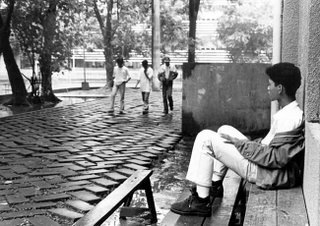 Anyway, since he was looking to the left, and there were only walls behind him, I placed him on the right side of the picture. I knew however that with such a set-up, there would be a lot of empty spaces on the left side. I waited for a while for something to happen. Then I saw these three students walking toward us. They were just the right lead-in element I needed! When they were just in the right spot, I took the shot.
Anyway, since he was looking to the left, and there were only walls behind him, I placed him on the right side of the picture. I knew however that with such a set-up, there would be a lot of empty spaces on the left side. I waited for a while for something to happen. Then I saw these three students walking toward us. They were just the right lead-in element I needed! When they were just in the right spot, I took the shot.
